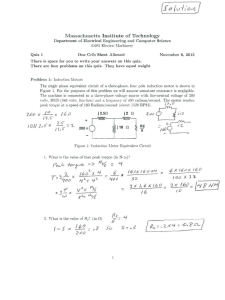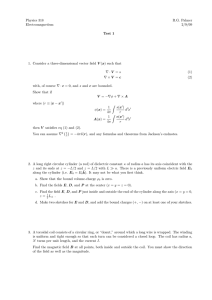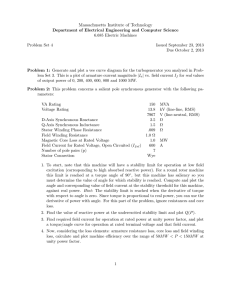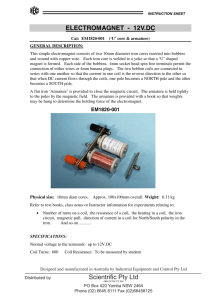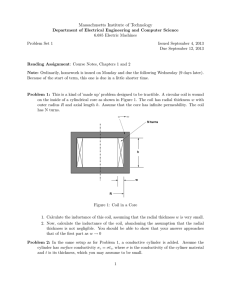Massachusetts Institute of Technology
advertisement
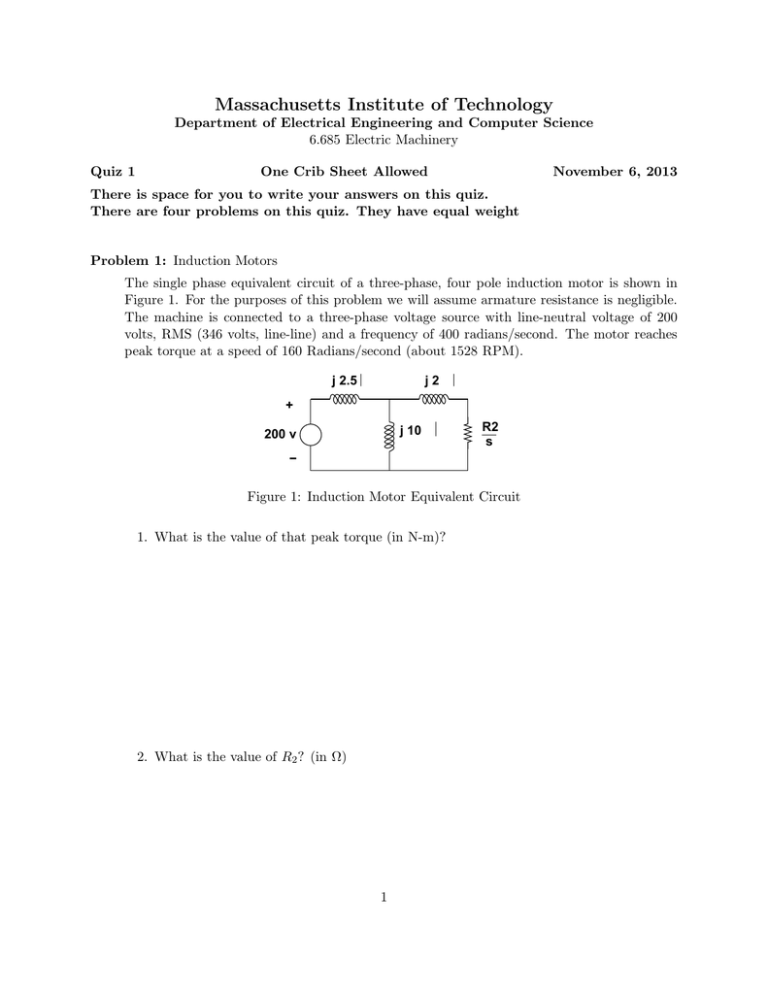
Massachusetts Institute of Technology Department of Electrical Engineering and Computer Science 6.685 Electric Machinery Quiz 1 One Crib Sheet Allowed November 6, 2013 There is space for you to write your answers on this quiz. There are four problems on this quiz. They have equal weight Problem 1: Induction Motors The single phase equivalent circuit of a three-phase, four pole induction motor is shown in Figure 1. For the purposes of this problem we will assume armature resistance is negligible. The machine is connected to a three-phase voltage source with line-neutral voltage of 200 volts, RMS (346 volts, line-line) and a frequency of 400 radians/second. The motor reaches peak torque at a speed of 160 Radians/second (about 1528 RPM). j2 Ω j 2.5Ω + j 10 Ω 200 v R2 s − Figure 1: Induction Motor Equivalent Circuit 1. What is the value of that peak torque (in N-m)? 2. What is the value of R2 ? (in Ω) 1 Problem 2 DC Machines A permanent magnet DC motor is connected to a 250 Volt (DC) source. Running ’light’ (no mechanical load), it draws negligible current and turns at a speed of 200 Radians/second. (about 1910 RPM). The armature circuit of the machine has a resistance of one Ω. Now the machine is loaded so that it is driving a load torque of 100 N-m, still connected to the 250 VDC source. 1. How much current is it drawing? 2. How fast is it turning? 2 Problem 3 Time constants Cylinder Conductivity µ σs N turns h Rc w R Figure 2: Pot Core with Coil and Shell Inside Shown in Figure 2 is a pot core with two elements inside: a coil with N turns is located at the outer radius of the cavity within the core. The other thing is a conductive shell of radius R and height h, which just fits inside the axial dimension of the cavity. The shell is thin and has surface conductivity σs . For the purpose of this problem, we are in a universe in which µ10 = 800, 000. The coil has 1,000 turns, the cylinder radius is Rc = 10cm and the coil radius is R = 20cm. Height of both elements and of the inside of the pot core is h = 10cm. 1. Assuming the coil is radially ’thin’, and ignoring the conductive cylinder, what is the coil inductance? 2. Now: assuming the conductive cylinder is ’perfectly diamagnetic’, meaning zero flux can penetrate it, as you would have with infinite cylinder conductivity, what is the coil inductance? 3 3. Assuming that the cylinder has surface conductivity of 80,000 S (reciprocal ohms), and the coil is driven by a step of 10 A, what is the magnetic field inside of the cylinder, as a function of time? 4 Problem 4 Synchronous Machine A three-phase, two pole synchronous machine has the following characteristics: Rated Power Rated Voltage Synchronous Inductance Field to Phase Mutual Inductance Synchronous Frequency PB VB La − Lab M ω0 3 1 2.5 25 400 MVA kV (Peak) mH mH Radians/Second Assume that armature resistance is negligible. 1. On no-load, open-circuit test at rated speed, what field current is required to produce rated voltage? 2. On short-circuit test, what field current is required to produce rated current? 3. Running at rated speed, with field current If = 300A and with rated armature terminal voltage (1,000 V, Peak, what is the peak torque the machine can produce? 4. Running at rated speed with field current If = 300A and with the armature driven by a balanced three-phase current of Ia = 3, 000A, Peak, what is the maximum peak torque that the machine can produce? 5 MIT OpenCourseWare http://ocw.mit.edu 6.685 Electric Machines Fall 2013 For information about citing these materials or our Terms of Use, visit: http://ocw.mit.edu/terms.
